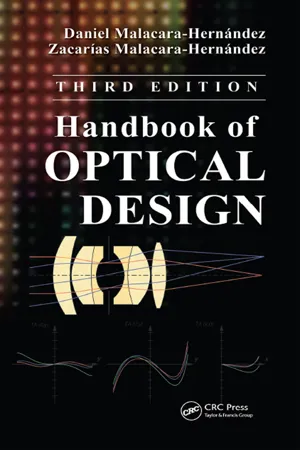
- 585 pages
- English
- ePUB (mobile friendly)
- Available on iOS & Android
Handbook of Optical Design
About this book
Handbook of Optical Design, Third Edition covers the fundamental principles of geometric optics and their application to lens design in one volume. It incorporates classic aspects of lens design along with important modern methods, tools, and instruments, including contemporary astronomical telescopes, Gaussian beams, and computer lens design. Written by respected researchers, the book has been extensively classroom-tested and developed in their lens design courses.
This well-illustrated handbook clearly and concisely explains the intricacies of optical system design and evaluation. It also discusses component selection, optimization, and integration for the development of effective optical apparatus. The authors analyze the performance of a wide range of optical materials, components, and systems, from simple magnifiers to complex lenses used in photography, ophthalmology, telescopes, microscopes, and projection systems. Throughout, the book includes a wealth of design examples, illustrations, and equations, most of which are derived from basic principles. Appendices supply additional background information.
What's New in This Edition
- Improved figures, including 32 now in color
- Updates throughout, reflecting advances in the field
- New material on Buchdahl high-order aberrations
- Expanded and improved coverage of the calculation of wavefront aberrations based on optical path
- An updated list of optical materials in the appendix
- A clearer, more detailed description of primary aberrations
- References to important new publications
- Optical system design examples updated to include newly available glasses
- 25 new design examples
This comprehensive book combines basic theory and practical details for the design of optical systems. It is an invaluable reference for optical students as well as scientists and engineers working with optical instrumentation.
Frequently asked questions
- Essential is ideal for learners and professionals who enjoy exploring a wide range of subjects. Access the Essential Library with 800,000+ trusted titles and best-sellers across business, personal growth, and the humanities. Includes unlimited reading time and Standard Read Aloud voice.
- Complete: Perfect for advanced learners and researchers needing full, unrestricted access. Unlock 1.4M+ books across hundreds of subjects, including academic and specialized titles. The Complete Plan also includes advanced features like Premium Read Aloud and Research Assistant.
Please note we cannot support devices running on iOS 13 and Android 7 or earlier. Learn more about using the app.
Information
Table of contents
- Cover
- Half Title
- Title Page
- Copyright Page
- Table of Contents
- Preface to the Third Edition
- Preface to the Second Edition
- Preface to the First Edition
- Chapter 1 Geometrical Optics Principles
- Chapter 2 Thin Lenses and Spherical Mirrors
- Chapter 3 Systems of Several Lenses and Thick Lenses
- Chapter 4 Chromatic Aberrations
- Chapter 5 Spherical Aberration
- Chapter 6 Monochromatic Off-Axis Aberrations
- Chapter 7 Aberration Polynomials and High-Order Aberrations
- Chapter 8 Computer Evaluation of Optical Systems
- Chapter 9 Diffraction in Optical Systems
- Chapter 10 Prisms
- Chapter 11 Basic Optical Systems and Simple Photographic Lenses
- Chapter 12 Complex Photographic Lenses
- Chapter 13 The Human Eye and Ophthalmic Lenses
- Chapter 14 Astronomical Telescopes
- Chapter 15 Visual Systems and Afocal Systems
- Chapter 16 Microscopes
- Chapter 17 Projection Systems
- Chapter 18 Lens Design Optimization
- Appendix 1: Notation and Primary Aberration Coefficients Summary
- Appendix 2: Mathematical Representation of Optical Surfaces
- Appendix 3: Optical Materials
- Appendix 4: Exact Ray Tracing of Skew Rays
- Appendix 5: General Bibliography on Lens Design
- Index